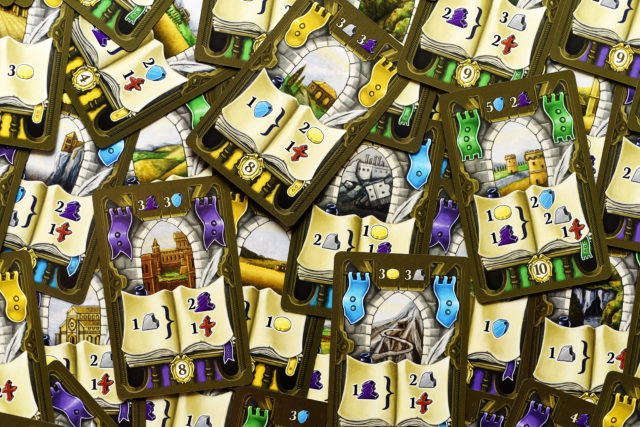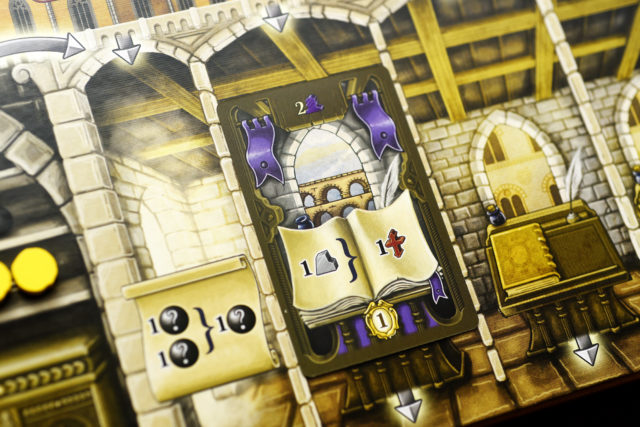It’s no surprise when a well loved board game inspires and spawns a card or dice derivation. Puerto Rico was boiled down to San Juan. Catan was transmuted into Catan: The Card Game, and then later, Rivals of Catan. Castles of Burgundy, Amun-Re, Tigris & Euphrates, Caylus, Ticket to Ride, Carcassonne… they’ve all seen the card game treatment; and the list certainly doesn’t end there. Then there are the dice games. Suffice it to say, retooling a popular game’s mechanisms to work in a simpler, more casual package is increasingly common. Is it because designers feel inspired to streamline their works, compelled by the challenge of stripping away layers of complexity to serve an elegant reimagining of a fan favourite? Or is it because it’s easier to sell Known Quantity: The Card Game than it is to market a new product?

Either way, I’m always thrilled when I can add a surprisingly deep card game to my Quiver, and I’m a big fan of Lorenzo il Magnifico, so I was plenty excited when it was announced that a card game was in the works. Unfortunately, upon playing Masters of Renaissance (a.k.a. Lorenzo Il Magnifico: The Card Game), my eager enthusiasm was itself stripped away, and by game end, disappointment had taken its place.
Masters of Renaissance is a fairly simple tableau building game with a moderately interesting element of resource management. Where Lorenzo (Il Magnifico) takes place over exactly 6 rounds, Masters (of Renaissance) sheds its predecessor’s worker placement mechanism in favour of an ongoing action selection format. Players take turns performing one of three main actions until such time as a player either reaches the end of the faith track or builds their 7th card. Once points are tallied, whichever player has collected the most is declared the victor.
Once the market tray is nestled into the market board, the cards are splayed out into a grid, the tiles are where they need to be, the resource supply is at the ready, and each player has their personal board, you quickly realize that Masters is no more a card game than Lorenzo was. And that’s perfectly fine, just don’t put a lie on the box.
On your turn, you will either:

The resource market is somewhat interesting, but ultimately a little random and gimmicky. Similar to the action selection mechanism in Ulm, you select a row or column of marbles, take the associated resources, and push the spare marble into that row/column, thereby displacing an existing marble and changing the market for the next player. It’s elevated somewhat by the cute and exceptionally functional market marble slide gadget that comes in the box.
You then have the challenge of properly storing your collected resources in your limited storage. Production will allow you to convert and offshore resources into your strongbox, which has no such limitations, but that takes a turn, and you often end up with less than you started with. However, you’ve now freed up space in your scarce resource storage. This challenge is essentially the game. It is impossible to collect enough resources to purchase the best cards without using production to offshore into your strongbox, but you are well rewarded for the careful planning required to purchase them.

Cards themselves cost 2 (level 1), 4 (level 2), or 7 (level 3) resources. When a card is purchased it is added to your tableau. Your tableau can only hold 3 active cards. However, you are welcome to cover previously purchased cards, and this, in fact, is the only way to acquire level 2 and level 3 cards, which can only be placed on top of cards exactly 1 level lower than their own. Higher level cards are worth more points than lower level cards, and make your production turns that much stronger, so they’re worth the effort.
When you choose to produce, you can use each of your production abilities once (those on your purchased cards, as well as the one printed on your player board), allowing you to convert resources held in your storage or strongbox into other resources. If you’ve planned well, you’re a little closer to buying better cards, or you’re moving along the piety track at a good pace, which can gain you points while depriving others, and even end the game in a hurry.
I’ve spoken about resources quite a bit, but not mentioned any of them but piety by name. Sadly, it’s because they are all functionally identical.
In Lorenzo:
In Masters:
This homogenization of resource function robs Masters of a key element that made Lorenzo great. It would have been lovely to see these different resources given varied impact on the game. Yes, each of the resources is associated with a particular card colour, but that’s where it begins and ends.

The lack of resource differentiation, paired with the ponderously slow early turns of the game, which are largely spent juggling resources, sufficiently ruined my experience with Masters, to the point where I’m confident that I will never want to play it again.
Perhaps my criticism wouldn’t be so harsh if Masters of Renaissance: The Lorenzo il Magnifico Card Game were actually a card game. It’s a card game in the same way that Through the Ages is: a game primarily powered by cards, but impossible to play without a wide variety of boards and tokens. If it can fit neatly into my Quiver, with few or no additional tokens, it’s a card game. If it can’t, it’s not. Am I wrong? Possibly.
Masters of Renaissance isn’t for me, but it could be for you. If you think you might enjoy a light resource management and conversion game with fairly simple rules, and don’t mind the homogenization of resources described above, I strongly believe there is plenty of room to play this game at a higher level. Paying close attention to what your opponents are doing, and identifying what they need from the resource and card markets can transform Masters’ decision space into something much more nuanced and clever than what one would otherwise appreciate at face value.
A media copy of Masters of Renaissance was provided for this article.
Comments
No comments yet! Be the first!